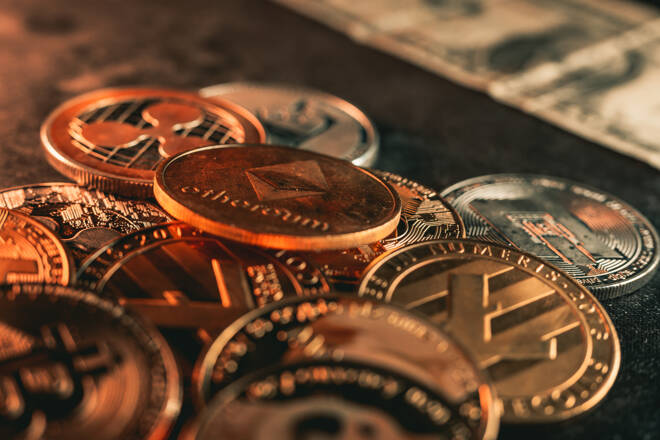Advertisement
Advertisement
DeFi Tokens to Keep an Eye on in August: AAVE, LDO, and UNI
By:
It was a bullish month for DeFi coins, with Lido DAO among the front runners. Improving market conditions should see DeFi coins draw more interest.
Key Insights:
- Improving crypto market conditions placed decentralized finance (DeFi) coins in the spotlight.
- A dovish 75-basis point Fed rate hike and the US economic contraction in the first and second quarters increased appetite for DeFi coins.
- While the crypto winter continues to hit the market, several DeFi coins have outperformed, including Uniswap (UNI), Lido DAO (LDO), and Aave (AAVE).
In July, the crypto market ended a three-month losing streak, with the total crypto market cap rising by $195 billion to $1,061 billion.
While a sizeable increase, the market cap is still down by $1,131 billion from $2,192 billion on January 1.
Improving market conditions, stemming from a shift in market sentiment towards Fed monetary policy, supported the beginnings of a crypto market recovery.
With current crypto price levels well below the first quarter and November all-time highs, buying opportunities are present.
While the risk of a US recession has spiked following the second consecutive quarterly contraction, US corporate earnings bolstered the appetite for riskier assets.
In July, the NASDAQ 100 rallied by 12.35%, the best monthly performance since 2020. Bitcoin (BTC) outperformed, with a 17.6% gain, with popular DeFi tokens among the crypto front runners for the month.
Total Value Locked Begins the Long Road to Recovery
According to Defi Llama, the total value locked (TVL) fell by 71% in H12022 to a lowly $71 billion. However, fortunes for the DeFi space changed in July. Reversing a large portion of the 37% slide in the June TVL, the TVL increased by 25% to $90.53 billion.
In July, Aave saw its TVL rise by a modest 8.2%, with Uniswap up 29%. However, LDO led the way, with the TVL surging by 61%.
Looking at the respective coin price and TVL performances,
| Coin | July 2022 | TVL July 2022 |
| AAVE | 73% | 8% |
| LDO | 372% | 61% |
| UNI | 69% | 29% |
The figures reveal a marked difference between price and TVL performance.
Improving market conditions should see market caps recover further to align more closely with total value locked levels.
Taking Uniswap as an example, the total market cap fell below the TVL in December and remained below the TVL. Another bullish month should see the Uniswap market cap narrow on the TVL, which would support another sizeable price move.
Aave (AAVE)
In July, AAVE rallied by 73% to end the month at $98.46. A bullish end to the month saw AAVE strike a July 31 monthly high of $109.33 before easing back.
Down by 61% year to date, a move through the June high of $120.83 would give AAVE a free run at the May high of $162.13.
AAVE would need to avoid sub-$50 and the current year low of $45.52 to continue the recovery.
However, crypto market conditions need to improve to support a return to $100. An upward trend in total value locked would provide support. With DeFi coins back on the radar, another bullish month could see AAVA join the front runners after trailing in July.
Lido DAO (LDO)
LDO surged by 372% in July to $2.13. Outperforming the broader market, LDO struck a July high of $2.658 on July 28 before easing back.
Down 31% year to date, a move through the May high of $3.56 would give LDO a free run at the April high of $5.14.
LDO would need to avoid sub$-2.00 and steer well clear of the current year low of $0.44 to support another breakout month.
Market risk sentiment will need to improve for LDO to revisit $5.00. An upward trend in total value locked would provide support. While market risk sentiment will influence, progress updates on the Ethereum (ETH) Merge will remain the key driver.
Uniswap (UNI)
In July, UNI rallied by 69% to end the month at $8.46. Tracking the broader market, UNI struck a July high of $9.82 on July 28 before easing back.
Down 50% year to date, a move through the April high of $12.30 would support a run at the January high of $19.85 to test resistance at $20.00.
However, UNI will need to avoid the sub-$5.00 and the July low of $4.72 to steer clear of the current-year low of $3.33.
While we can expect total value-locked trends to influence, the crypto market sentiment would need to improve to support a breakout from the April high.
For UNI, investors will also monitor the impact of the Fee Switch, which delivered price support in late July.
About the Author
Bob Masonauthor
With over 28 years of experience in the financial industry, Bob has worked with various global rating agencies and multinational banks. Currently he is covering currencies, commodities, alternative asset classes and global equities, focusing mostly on European and Asian markets.
Did you find this article useful?
Latest news and analysis
Advertisement
